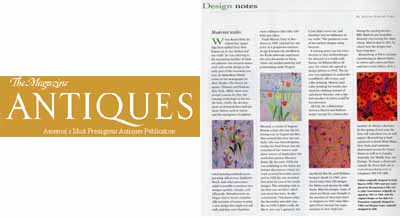
The Magazine Antiques; 9/1/2005; Ledes, Allison Eckardt
When Raoul Dufy declared that "paintings have spilled from their frames on to our clothes and our walls" he was referring to the increasing number of modern painters who became enamored with textile design in the early part of the twentieth century. As Alain-Rene Hardy writes in his monograph Art Deco Textiles: The French Designers (Thames and Hudson, New York, 2003), there were several reasons for this. Advancing technology in the textile field, chiefly the development of chemical dyes and synthetic fabrics such as rayon, and the emergence of sophisticated printing methods incorporating silk-screen, linoleum-block, and other processes, made it possible to produce new designs quickly, cheaply, and efficiently. Manufacturers no longer had to invest considerable amounts of money to print a new design that might not sell well, and they were therefore more willing to take risks with bold new ideas.
[ILLUSTRATION OMITTED]
Paule Marrot, born in Bordeaux in 1902, reached her majority at a propitious moment. At age fourteen she enrolled in the Ecole nationale superieure des arts decoratifs in Paris, where she studied painting and printmaking under Eugene Morand, a cousin of Auguste Renoir, whom she met the following year in Cagnes-sur-Mer. Also around this time she met Dufy, who was then designing textiles for Paul Poiret, but she considered her mentor and main source of inspiration the symbolist painter Maurice Denis. By the early 1920s she was exhibiting at the Salon des Artistes decorateurs where her work received favorable notice, and in 1928 she was awarded first prize for one of her textile designs. The emerging style at the time was art deco, which was never her forte. As she commented, "You know what the decorative arts style was like in 1930. I didn't really dislike it, nor was I against it, but it just didn't move me, and therefore had no influence on my work." She produced some of her earliest designs using linocuts.
[ILLUSTRATION OMITTED]
A turning point was her introduction to Jean Schlumberger, the director of a textile mill, Steiner de Ribeauville in Alsace, for whom she agreed to design fabrics in 1932. The factory was equipped to undertake woodblock, silk screen, and roller printing. Marrot used roller printing for textiles destined for clothing instead of upholstery because only a limited number of colors could be incorporated.
All told, the collaboration between Marrot and Schlumberger (except for a hiatus during World War II), until Schlumberger's death in 1963, produced more than 320 designs for fabrics and dozens for table linens. Marrot's designs, many of which are floral, were brought to the attention of American interior designers in 1945 when Margaret Owen became her representative in New York City. During the ensuing decades, Billy Baldwin and Jacqueline Kennedy were among her many clients. Marrot died in 1987, by which time her designs had been forgotten.
[ILLUSTRATION OMITTED]
Brunschwig et Fils is currently reproducing six Marrot fabrics in cotton and linen and four woven fabrics, all in a number of vibrant colorways. In the spring of next year, the firm will reproduce two as wallpapers. Brunschwig is headquartered in North White Plains, New York, and maintains showrooms across the United States as well as in Canada, Australia, the Middle East, and Europe. To locate a showroom consult the firm's Web site at www.brunschwig.com or telephone 800-538-1880.
[ILLUSTRATION OMITTED]
COPYRIGHT 2005 Brant Publications, Inc.
Back | The Magazine Antiques